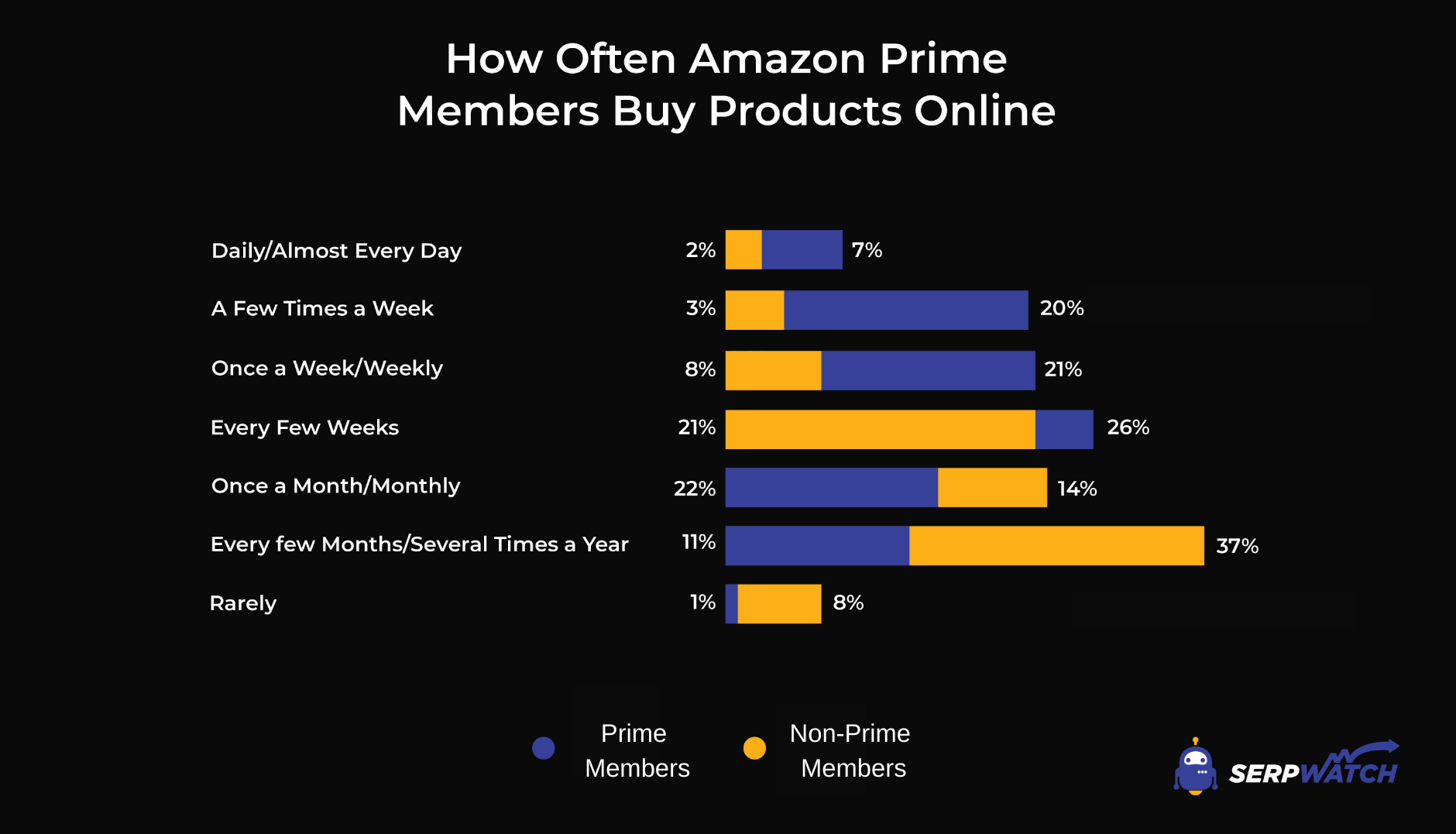
Amazon Customer Demographics: Prime Users, Target Market, and More in 2024

We all know that Amazon is the largest online retailer of electronics, clothing, music, books, and many other goods. On top of that, Amazon’s subscription services attract millions of users worldwide.
That’s why learning about Amazon demographics can provide marketers with a better understanding of consumer behavior. Likewise, SEO specialists can use these insights to improve their content and digital marketing strategies.
So, let’s check out the latest data related to Amazon demographics.
Top Amazon Customer Demographics and Stats | Editor’s Choice
- Amazon’s mobile shopping app had 150.6 million users in 2019.
- The global Amazon marketplace has 6.3 million sellers.
- 85% of young consumers buy online at least once a week.
- The Amazon Prime membership base has over 200 million users worldwide.
- The average Amazon Prime member spends $1,400 a year on online shopping.
- The average age of an Amazon consumer is 37.
- 43% of consumers click on Amazon ads while browsing the web.
- 79.8% of Amazon customers say that free and fast shipping is the primary reason for shopping on the platform.
How Many People Use Amazon?
Over the years, Amazon has grown into an ecommerce juggernaut with hundreds of millions of consumers.
Thus, Amazon provides the perfect opportunity for businesses to reach a massive audience. Therefore, SEO specialists working on affiliate websites should pay attention to the following numbers.
1. In September 2019, Amazon’s mobile shopping app had 150.6 million users.
Amazon was among the pioneers of online shopping, and it also played a vital role in the rise of mobile shopping. As expected, Amazon tops the list of the most popular apps.
For instance, Amazon user statistics show that the second most popular app is Walmart’s app, with around 86 million monthly users.
2. In total, the Amazon marketplace has 6.3 million sellers worldwide.
The Amazon marketplace has 387,000 new sellers this year. However, most registered sellers are no longer active, but they have products listed for sale. More precisely, around 1.5 million sellers are active today.
3. 43% of consumers say that Amazon has become more important to them because of the pandemic.
According to a recent Amazon shopper survey, 19% of consumers say that next-day delivery is among the main reasons they shop on Amazon. Therefore, the outbreak of COVID-19 boosted the need for efficient and reliable delivery.
Despite our need for instant gratification, only 6% of consumers say they rely on same-day deliveries.
4. Small and medium-sized businesses account for around 60% of retail sales on Amazon.
Amazon provided SMBs with a platform to sell their goods to a global audience hassle-free. That’s why the number of these companies in the Amazon marketplace continues to grow.
Namely, the Amazon demographics report reveals that more than 1.9 million small and medium-sized businesses sell via this ecommerce platform.
5. 85% of consumers aged 18 to 32 years buy online at least a few times per week.
Overall, 58% of consumers shop online at least once every few weeks. Thus, it’s clear that the retail culture now relies heavily on ecommerce.
Moreover, 18% of Feedvisor’s survey respondents admit to buying online a few times per week. Plus, almost half (48%) of Amazon Prime members buy online once a week or more frequently.

6. According to Amazon customer demographics, 65% of consumers aged 33 to 40 years visit Amazon at least a few times per week.
The ever-increasing dominance of ecommerce is also changing the way we browse the internet. For example, a visit to Amazon’s website is on a weekly schedule for many consumers worldwide.
At the same time, affiliate websites must strive toward improving their SEO game to reach potential consumers. Of course, rank trackers like SerpWatch can be a valuable tool in the battle for a higher position in SERPs.
Amazon Yearly Revenue Stats and Facts
Amazon’s diversified portfolio comprises several companies and services, and most of them are highly profitable. As a result, Amazon makes jaw-dropping profits and sets the standard for online shopping year after year. So, here are the numbers to prove it.
7. In 2020, Amazon’s annual net revenue amounted to $386.06 billion.
During the pandemic, many people relied on Amazon’s home delivery services to provide them with goods. Consequently, this ecommerce platform generated record-breaking revenue.
In comparison, the 2019 Amazon yearly revenue was $280.5 billion. The company generates most of its income through retail product sales, but Amazon users have many other services at their disposal.
8. Amazon’s annual net revenue from subscription services in 2020 amounted to $25.21 billion.
In recent years, the subscription services segment has grown to become one of the most prominent product groups. Amazon Prime is one of those subscription services with over 150 million paying members.
9. Amazon consumers spent 7.6% more on Prime Day in 2021 than in 2020.
Amazon demographics for 2021 show that the sales on Prime Day still attract a massive audience. But, most importantly, consumers are willing to spend. More precisely, on June 21 and June 22, the total sales reached $11.19 billion.
In comparison, the sales on Amazon Prime Day in October 2020 reached $10.39 billion. In 2021, the best-selling categories included tools, nutrition, beauty, and electronics.
10. The Amazon Prime membership base has over 200 million users worldwide.
Although the official information regarding Amazon Prime was scarce until recently, the latest Amazon Prime customer demographics studies show a significant increase in the numbers of paid members—50 million more between Q4 of 2019 and Q1 of 2021.
11. On average, Prime members yearly spend $1,400 on online shopping.
As expected, Amazon Prime members spend more time and money on Amazon than non-Prime members. According to 2019 data, non-Prime members spend around $600 a year. So, Prime members spend twice as much, even though they also have to pay for the subscription.
Amazon Customer Demographics for 2021
These days, it seems like everyone is ordering something from Amazon. Likewise, marketers from all sides are competing for positions in SERPs to refer visitors to Amazon products. So, to get the grips with the situation, let’s see what the stats say about Amazons’ customers.
12. The average Amazon user is 37 years old.
According to a June 2019 report, 53% of Amazon users are between 19 and 44 years old. This particular age group corresponds to 37% of the American population.
Therefore, Amazon buyer demographics show that the company targets the average American consumer. As a result, many customers are loyal to Amazon’s online services.
13. The average Amazon buyer has an annual household income of $84,449.
In a 2019 survey on the average consumers at Walmart and Amazon, the results showed a notable difference regarding the shopper’s income. Namely, Walmart dominates the low-income demographic, and the average Walmart shopper has an annual income of $76,313.
Also, the data gathered after surveying 3,000 consumers revealed that the average shopper at both these chains is a 46-year-old white woman.
14. The Amazon Prime demographics in June 2020 showed that 81% of US adults between the ages of 18 and 34 were Amazon Prime members.
During the COVID-19 pandemic, Amazon experienced an uptick in subscriptions for the Prime program. To be precise, the percentage of US adults aged 18 to 34 years who had Amazon Prime accounts jumped by 11% from February 2020.
Also, the pandemic triggered a rise in Prime memberships across all age groups.
15. 67% of Amazon Prime members are parents or guardians of a child under 17 living at home.
According to Amazon Prime membership statistics, consumers with household incomes higher than $150,000 are more likely to subscribe than those with incomes under $25,000.
Likewise, the product price drives buying decisions. Overall, 82% of Amazon shoppers admit that price is the essential factor in the buying process.
16. 43% of consumers click on advertisements linking to Amazon products.
While surfing the web, younger consumers are more likely to click on Amazon ads. Google is the top referrer, with 76% of consumers citing Google as the source of the ad. The second-best referral source is Facebook, with 49% of consumers clicking on Amazon ads.
Optimizing images for SEO is also a smart way to increase product visibility not only in Amazon’s search engine, but Google’s as well.
Statistics About the Amazon Target Markets
In almost any line of business, knowing your customers is an essential step on the path to success. Like SEO experts track rankings and analyze keywords, Amazon also collects and studies data on its users. By doing so, it can expand into various markets.
17. The category “books” accounts for 76% of the total products on Amazon.
As we all know, Amazon started as a book-selling website. In essence, Bezos launched an online bookstore, running the business from a garage in Washington.
So, it’s not surprising to see book lovers as one of the primary Amazon target markets in 2021. In total, the online bookstore has 57.2 million products in the “books” category.
18. Amazon Fire TV has more than 50 million active monthly users.
Amazon Fire TV is another consumer-focused service provided by Amazon that offers a personalized streaming experience. In other words, Fire TV will let you play, watch, and listen to what you want, when you want.
Amazon is continuously optimizing the service, so the Amazon Fire TV user base should grow in upcoming years.
19. In 2020, 71.3 million US households had Amazon Prime.
Potential Prime members are the primary Amazon target audience, mainly because the average subscriber to Amazon Prime spends more money than a non-Prime consumer.
As a result, the number of members will probably continue to grow, reaching 76.6 million American households by 2022.
20. 68% of Amazon shoppers had Amazon Prime accounts in October 2020.
Amazon Prime offers a range of perks and benefits, attracting users of all ages. With more than two-thirds of Amazon shoppers having Amazon Prime accounts, the company generates more revenue than ever.
For example, the record-breaking sales in the last quarter of 2020 amounted to $96.1 billion.
21. According to Amazon buyer demographics, 64% of Amazon sellers are men.
A recent demographic study has revealed that around a third (32%) of sellers on Amazon are women. So, Amazon’s marketplace still has a long way to go before getting close to gender equality.
In addition, JungleScout reports that 58% of all Amazon sellers are between 25 and 44 years old, with the most common age being 39.
22. 71% of Amazon sellers have a bachelor’s degree or higher.
Overall, Amazon sellers are well-educated and well-versed in modern technologies. In addition, Amazon customer demographics show a similar pattern. As we’ve already mentioned, Amazon targets higher-income consumers as opposed to Walmart.
Likewise, 70% of Amazon sellers have jobs other than their Amazon shops. Precisely, 36% of sellers have full-time jobs. Yet, 22% generate income only by selling on Amazon.
23. 82% of people aged 20–29 are Amazon Prime membership holders.
Moreover, Amazon’s market segmentation reveals that younger consumers are more likely to subscribe to Amazon Prime than older shoppers. For instance, 64% of Amazon shoppers over 70 are Prime membership holders.
24. In 2020, 79.8% of consumers said that fast and free shipping was the primary reason to shop via Amazon.
Amazon offers a broad selection of products. That’s why 68.9% of consumers shop on Amazon since the platform has everything they might need.
Yet, the convenience of fast and free delivery remains the top incentive for buying on the platform for most of Amazon’s target market demographics. Another reason is that consumers are already Prime membership holders (65.7%).
25. 93% of Amazon Prime members continue to pay for the service after one year.
As they say—once you go Prime, you never go back. For instance, 98% of Prime membership holders stay signed up after using the program for two years.
Since Amazon is all about customer satisfaction, 70% of consumers who used Amazon Prime for a year or more admit to being very satisfied with the service.
Amazon Customer Demographics | The Takeaway
The Amazon empire spans continents and regions, and this multinational enterprise is showing no signs of stopping. Moreover, Amazon’s growth potential is still high, and many people can benefit from selling on the platform or through other channels.
For instance, ranking your products high on Amazon can help generate higher ROI. But, of course, the trick is in optimizing your pages and creating content with SEO in mind.
That’s where apps like SerpWatch can make your life much easier. After using SerpWatch, your affiliate websites will see an uptick in ranking, positively impacting the ROI.
Frequently Asked Question | FAQ
Who are Amazon’s target customers?
From its inception, Amazon has been focusing on customers’ needs, earning the title of one the most customer-centric companies. In essence, Amazon goes above and beyond to meet the needs of every customer. So, this massive ecommerce platform targets consumers of all ages, genders, and financial backgrounds.
For instance, in 2017, Amazon launched a service targeting America’s teenagers, allowing them to shop with a unique login. Nowadays, the company is expanding its operations, aiming to provide services to a worldwide audience.
How old is the average Amazon customer?
In many ways, Amazon depicts modern American society and our new way of life. So, it’s not surprising to see that the average Amazon customer is around 37 years old, employed, and familiar with mobile devices, voice assistants, and online shopping.
For instance, statistics from January 2020 reveal that 81% of US adults aged 18 to 34 were Amazon Prime members. But, of course, this specific demographic group comes with the financial potential to pay for exclusive online shopping services.
How much does Amazon make a year?
It’s no secret that Amazon is among the top-earning corporations on the planet, with Jeff Bezos topping the list of the wealthiest business executives. And even though the founder and long-standing CEO is currently not at the helm, Amazon still breaks records and earns staggering amounts.
To be precise, Amazon reported $21.33 billion of net income in 2020, while the overall company’s revenue for the same period amounted to $386 billion. Admittedly, the pandemic affected the results in 2020, but it’s clear that Amazon generates jaw-dropping amounts.
What countries does Amazon ship to?
Worldwide shipping has been one of Amazon’s goals from the early days, and those dreams are now a reality. Thanks to the benefits of ecommerce, Amazon’s network of storage centers and support hubs can deliver goods with lightning speed.
Currently, Amazon delivers products to more than 100 countries and regions besides the United States. But, of course, your shipping destination could affect the availability of specific items. Therefore, checking if the product is eligible for Amazon Global is essential before placing an order.
How many countries does Amazon operate in?
Nowadays, most people shop online, and Amazon was among the first ecommerce platforms to popularize online shopping. Also, this international enterprise has conquered the world with its fast home deliveries, low prices, and excellent customer support.
For example, Amazon has 15 websites. Likewise, the exclusive Amazon Prime is available in 20 countries. Overall, Amazon’s famous packaging arrives at people’s homes in more than 100 countries worldwide. Moreover, new storage centers and delivery hubs are likely to appear in the upcoming years, expanding Amazon’s network and reach.
How many people have Amazon Prime?
Available in several countries, Amazon Prime is a subscription model granting exclusive benefits for a yearly fee of $119. Established in 2005, Amazon Prime covers several areas, including the three Ss: shipping, shopping, and streaming. As a result, more and more users are opting for the Prime package.
To be precise, around 200 million people worldwide are using this membership program, with about 147 million members in the United States. Overall, people from 20 countries have access to Amazon Prime.
What percent of Amazon customers have Prime?
Amazon Prime was launched in 2005, and it has been gradually increasing offerings ever since, especially in the last few years. Today, with more than 200 million users, this subscription program generates massive profits, but it also provides members with plenty of benefits.
Amazon Prime is on the verge of having 150 million subscribers in the US, while the global customer base amounts to 200 million. In 2019, studies showed that 65% of Amazon users also opted for Prime service. During the pandemic, this percentage probably grew significantly.
How many households have Amazon Prime?
Having an Amazon Prime membership is no longer a status symbol because it feels like most people have it these days. Admittedly, the number of Prime subscribers has increased significantly since 2005, but the surveys in 2019 showed that “only” 66.4 million households in the US had a subscription to the service.
As expected, the outbreak of COVID-19 inspired a wave of membership applications, so the number of households with Amazon Prime grew to 74.4 million. According to the latest Amazon customer demographics, 76.6 million households are expected to have Amazon Prime by 2022.
Sources
Amazon, Business Standard, Digital Commerce 360, Digital Commerce 360, Feedvisor, Goat Consulting, Insider, JungleScout, Marketplace Plus, Marketwatch, ScrapeHero, Statista, Statista, Statista, Statista, Statista, Statista, Statista, Statista, The New York Post






There are currently no comments.
Be the first!))